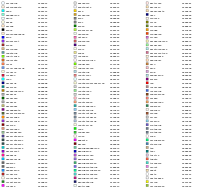Web colors
Web colors have an unambiguous colorimetric definition, sRGB, which relates the chromaticities of a particular phosphor set, a given transfer curve, adaptive whitepoint, and viewing conditions.[4] These have been chosen to be similar to many real-world monitors and viewing conditions, to allow rendering to be fairly close to the specified values even without color management.A hex triplet is a six-digit (or eight-digit), three-byte (or four-byte) hexadecimal number used in HTML, CSS, SVG, and other computing applications to represent colors.For instance, the RGB value 58 (as shown in the previous example of hex triplets) divides into 3 groups of 16, thus the first digit is 3.Likewise, the RGB value 201 divides into 12 groups of 16, thus the first digit is C. A remainder of nine gives the hexadecimal number C9."[9] Extended colors are the result of merging specifications from HTML 4.01, CSS 2.0, SVG 1.0 and CSS3 User Interfaces (CSS3 UI).The list of colors shipped with the X11 product varies between implementations and clashes with certain of the HTML names such as green.This enables web authors to style their content in line with the operating system of the user agent.[22] The CSS3 specification also introduces HSL color space values to style sheets:[23] CSS also supports the special color transparent, which represents an alpha value of zero; by default, transparent is rendered as an invisible nominal black: rgba(0, 0, 0, 0).Some sections explaining color theory and common operations like gamut mapping are also added to aid implementation.A set of colors was needed that could be shown without dithering on 256-color displays; the number 216 was chosen partly because computer operating systems customarily reserved sixteen to twenty colors for their own use; it was also selected because it allowed exactly six equally spaced shades of red, green, and blue (6 × 6 × 6 = 216), each from 00 to FF (including both limits).Values flanked by "*" (asterisk) are part of the "really safe palette;" see Safest web colors, below.They called these 22 colors "the really safe palette"; it consists largely of shades of green, yellow, and cyan.For these displays or blind and colorblind users, Web content depending on colors can be unusable or difficult to use.As a report to the Web Accessibility Initiative indicates,[34] dyslexic readers are better served by contrast ratios below the maximum.

Dynamic HTMLarticlecanvasMobile ProfileHTML elementdiv and spanmarqueeHTML attributealt attributeHTML frameHTML editorCharacter encodingsnamed charactersUnicodeLanguage codeDocument Object ModelBrowser Object ModelStyle sheetsFont familyJavaScriptWebGPUValidatorWHATWGQuirks modeWeb storageRendering engineDocument markup languagesComparison of browser enginescolorsdisplaying web pagesWorld Wide Webhexadecimalcolor toolgraphics softwarenumber signCascading Style SheetsMosaicNetscape NavigatorX11 color namesX Window Systemchromaticitiesphosphormonitorscolor managementUser agentsWeb-to-printalpha channel24-bit RGB color schemeconcatenatingoperating systemsSilverMaroonYellowFuchsiaPurpleweb browsersSVG 1.0SVG FullSVG TinymagentaOrangeoperating systemdeprecatedHSL color spacegamut mappingdevice independent colorCIE Lab and LCHOKLab and OKLCHgamutsDisplay P3ProphotoREC.2020Adobe 1998 RGBCSS WGEric MeyerHWB color modelICC profilesColor depth1-bit monochrome8-bit grayscale8-bit color15- or 16-bit color (high color)Indexed colorPaletteRGB color modelditheringquantizeTrueColor16-bit computer displaysbrowsersWeb Content Accessibility Guidelinesrelative luminanceWeb Accessibility InitiativedyslexicAdobe RGB color spaceCIE 1931 XYZ color spaceL*a*b* color spaceColor pickerList of color palettesLists of colorsList of colors by shadeProPhoto RGBRGB color spacesWide-gamut RGB color spaceMDN Web DocsGray/GreyAqua/CyanNavy blueColor scienceElectromagnetic spectrumRainbowVisibleSpectral colorsChromophoreStructural colorationAnimal colorationColor of chemicalsSpectral power distributionColorimetryColor perceptionChromesthesiaSonochromatismColor blindnessAchromatopsiaDichromacyColor calibration